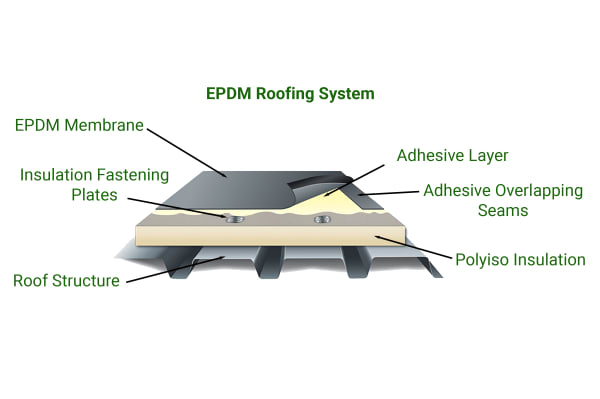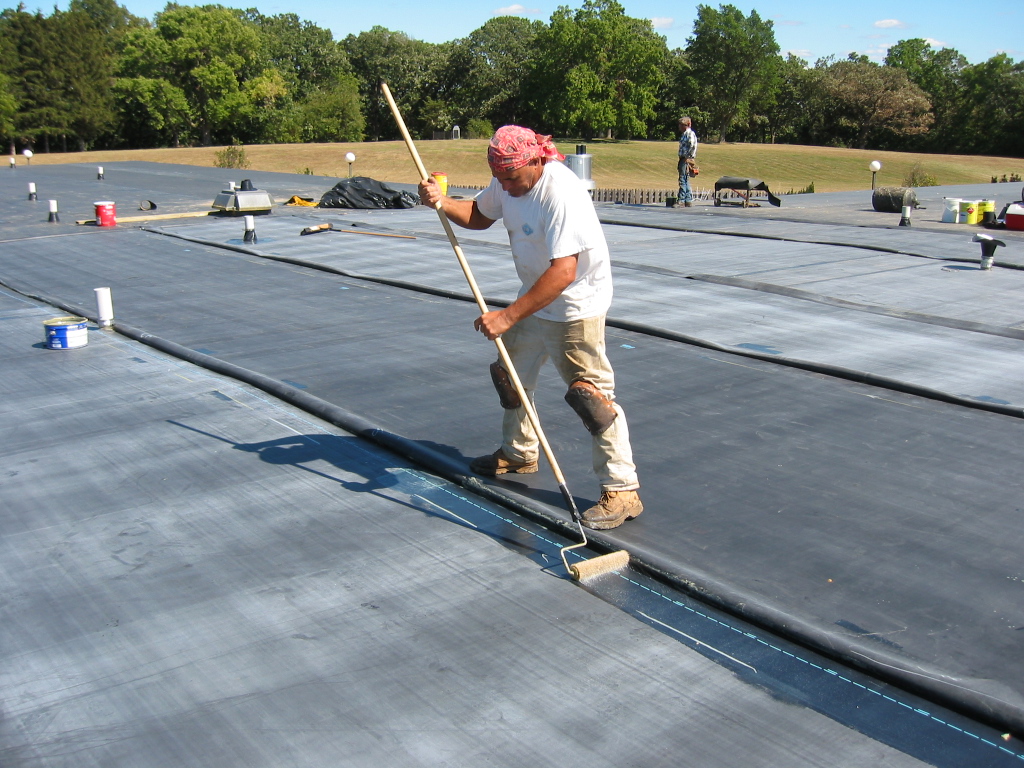Did you know that over 20 billion square feet of EPDM roofing have been installed across the U.S.? It’s one of the most popular roofing systems for commercial and flat-roof buildings. But popularity doesn’t always mean it’s the right choice for your needs. In this post, we’ll explore the key advantages and disadvantages of EPDM roofs so you can make an informed decision.
What Is an EPDM Roof?
EPDM stands for Ethylene Propylene Diene Monomer. It’s a type of synthetic rubber roofing membrane known for its durability and flexibility. Commonly used on flat or low-slope roofs, EPDM comes in large rolls that are black or white and typically 45 to 60 mils thick.
There are three primary installation methods:
-
Fully adhered (glued down)
-
Mechanically fastened (secured with fasteners)
-
Ballasted (held in place with rocks or pavers)
Its flexibility makes it ideal for roofs that may expand or contract due to temperature changes.

Best Types of Buildings for EPDM Roofing
EPDM roofing is a versatile roofing option, but it’s especially well-suited to certain types of buildings. Its flexibility, durability, and cost-effectiveness make it a go-to choice for:
1. Commercial and Industrial Buildings
Large warehouses, factories, and office buildings often have flat or low-slope roofs, making them ideal candidates for EPDM. The material’s wide roll sizes reduce seams, which helps minimize leak risks on expansive surfaces.
2. Educational and Institutional Facilities
Schools, universities, and hospitals benefit from EPDM because of its long lifespan and low maintenance requirements. White EPDM versions also provide energy savings, which is especially valuable for high-occupancy buildings.
3. Multifamily Housing and Apartment Complexes
Flat-roof apartment buildings often rely on EPDM because it’s affordable, durable, and easy to repair. Property managers appreciate that minor damage can be fixed quickly without replacing the entire system.
4. Residential Flat Roofs
While less common than commercial use, EPDM can be a solid option for homes with flat or low-slope roof designs. It’s not the most stylish choice, but it delivers strong weather protection at a reasonable cost.
Pros of EPDM Roofing
1. Budget-Friendly Roofing Option
EPDM is one of the most cost-effective flat roofing systems available. Installation costs range from $4 to $8 per square foot, which is significantly lower than other materials like TPO or PVC. It also lasts for decades, reducing replacement costs.
2. Long-Lasting Durability
When properly installed, an EPDM roof can last 25 to 30 years or more. It’s resistant to UV radiation, hail, wind, and even extreme temperatures. The material doesn’t crack or deteriorate easily, making it a reliable long-term solution.
3. Low Maintenance and Easy Repairs
EPDM requires very little upkeep. Most damage, such as small punctures or tears, can be patched with simple adhesive kits. This makes it a good option for building owners looking to minimize maintenance time and costs.
4. Environmentally Friendly Choice
EPDM is recyclable, which makes it a greener option compared to asphalt-based materials. Additionally, white EPDM reflects sunlight, helping to reduce cooling costs in hot climates.
Cons of EPDM Roofing
1. Basic Appearance
EPDM is functional but not attractive. It’s typically black (though white versions are available) and has a plain, industrial look. This makes it less appealing for homes or buildings where roof aesthetics matter.
2. Puncture Risks
The rubber membrane can be damaged by falling branches, tools, or heavy foot traffic. Extra protection may be needed in areas that people walk on frequently.
3. Installation Errors Can Lead to Problems
If not installed properly, EPDM roofs can suffer from seam separation or leaks. It’s essential to hire experienced roofing contractors to avoid costly issues later.
4. Shrinkage Over Time
EPDM may shrink slightly over the years, especially if exposed to constant heat. This can cause the material to pull away from edges or flashing, requiring resealing or repairs.
Is an EPDM Roof Right for You?
EPDM roofing is best for:
-
Commercial buildings with flat or low-slope roofs
-
Budget-conscious projects
-
Owners looking for a long-lasting, low-maintenance solution
It may not be ideal for:
-
Sloped residential roofs
-
Projects where curb appeal is a top priority
-
High-traffic rooftop areas
Is an EPDM Roof Right For You?
EPDM offers a reliable, affordable, and eco-friendly roofing solution—but it’s not perfect for every situation. Consider your budget, roof type, and appearance needs before making a decision. Always consult with a certified roofer to ensure EPDM is the right fit for your building.

